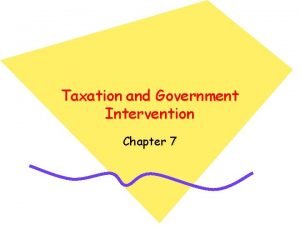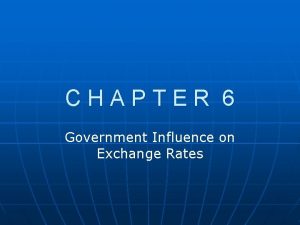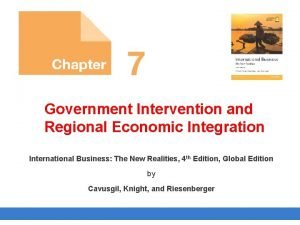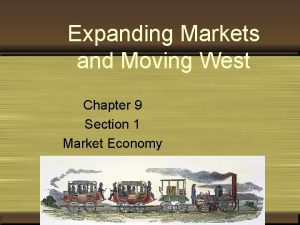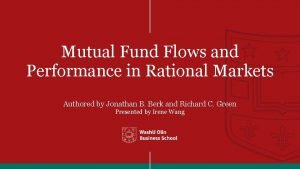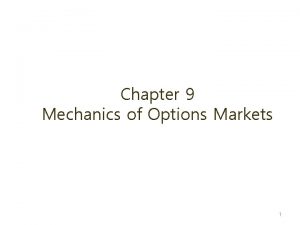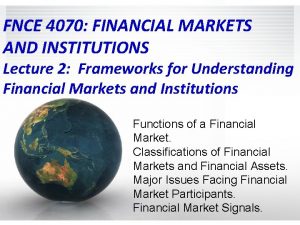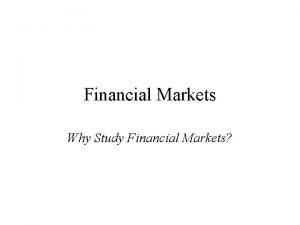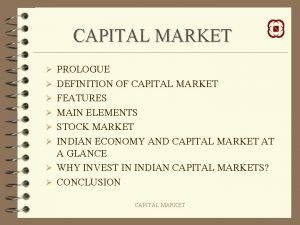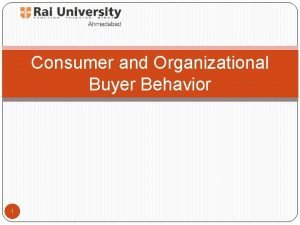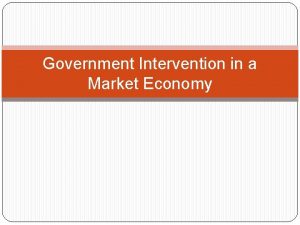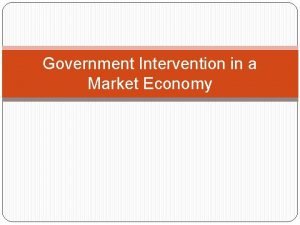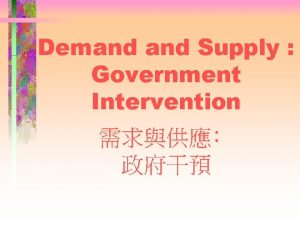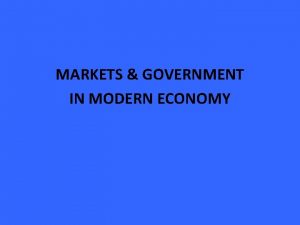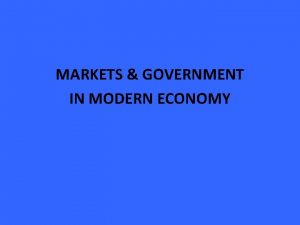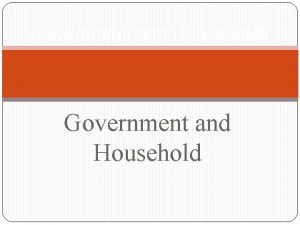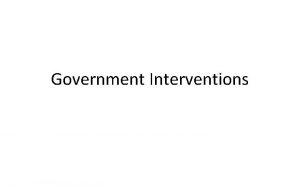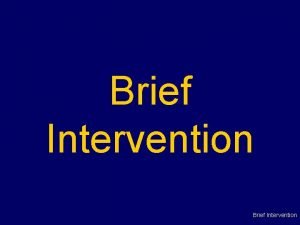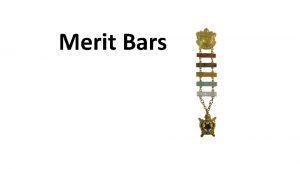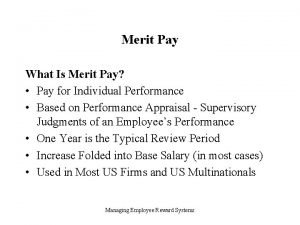1 5 8 Government intervention in markets Merit


























- Slides: 26

1. 5. 8 Government intervention in markets Merit Demerit Public goods Y 1: 4. 1. 8 The market mechanism, market failure and government intervention in markets Add an example to each circle Social costs Social benefits AS: 3. 1. 5 The market mechanism, market failure and government intervention in markets

1. 5. 8 G OVERNMENTINTERVENTION IN MARKETS The existence of market failure, in its various forms, provides an argument for government intervention in markets Governments influence the allocation of resources in a variety of ways, including through public expenditure, taxation and regulations Governments have a range of objectives and these affect how they intervene in a mixed economy to influence the allocation of resources The use of indirect taxation, subsidies, price controls, state provision and regulation to correct market failure You should be able to apply economic models to assess the role of markets and the government in a variety of situations You should appreciate the consequences of government intervention in markets for consumers, producers and other economic agents You should be able to evaluate the case for and against government intervention in particular markets and to assess the relative merits of different methods of intervention

T HE REASONSFOR GOVERNMENTINTERVENTION TO IN MARKETS Governments intervene in order to reduce market failure to: Reduce or eliminate negative externalities Should the government intervene? Increase or maximise positive externalities Increase the supply of merit goods Recap. Why are public goods undersupplied by the market? Reduce the supply of demerit goods Supply public goods that would be undersupplied by the market

T HE REASONSFOR GOVERNMENTINTERVENTION IN MARKETS In order to reduce inequalities in the distribution of income and wealth: Unequal distribution can lead to poverty Tensions in society can be created A breakdown in society can cause further market failure Child poverty in the UK Should we redistribute income to help society?

T HE REASONSFOR GOVERNMENTINTERVENTION TO IN MARKETS Governments intervene in order to support UK industry: Full employment is a government target Certain industries are more important than others as they employ large amounts of labour Should government support industry? Infrastructure is essential if business are to provide quality services Infrastructure in emerging markets.

L OOKINGAHEAD How do you think the Government might intervene?

G OVERNMENTSINFLUENCETHE ALLOCATIONOF RESOURCES Governments influence the allocation of resources through: Public expenditure: Taxation and subsidies: government spending to pay for the needs of society such as health, education, infrastructure etc. making it more expensive for products that cause high negative externalities and cheaper for those that cause positive externalities Regulation: protecting consumers from the abuse of monopoly power that would lead to higher prices, supernormal profits and allocative inefficiency creating an environment that will encourage firms to strive for productive efficiency through reduced costs

G OVERNMENT OBJECTIVESINFLUENCETHE ALLOCATIONOF RESOURCES Economic growth as a key objective Job creation Rising incomes Improved standards of living Improved international competitiveness of UK economy Improved confidence of: consumers to spend business to invest Lower government spending on job seekers allowance and associated benefits Tax revenues are likely to increase allowing the government to re-invest in infrastructure or spend on public services

G OVERNMENT OBJECTIVESINFLUENCETHE ALLOCATIONOF RESOURCES Unemployment as a key objective: Higher demand Higher incomes Improved standards of living Higher tax revenue for government Lower government spending on unemployment related welfare Improved productivity of UK economy Reduced poverty Social benefits (reduced crime, improved wellbeing) Increased spending might impact on merit goods as it will probably directed at the NHS and education

G OVERNMENTOBJECTIVESINFLUENCETHE ALLOCATIONOF RESOURCES Inflation as a key objective: Inflation is important because it affects the value of money in your pocket, workers wage demands and consumer confidence High, or rising inflation, damages the real value of money and erodes spending power An inflation target of 2% has been set by the government Reducing demand will impact on inflation but might lead to less spending on merit goods

T HE WAYSIN WHICHGOVERNMENTSINTERVENE TO CORRECTMARKETFAILURE There a number of ways in which governments can intervene to correct market failure These include: Indirect taxation Subsidies Price controls State provision Regulation

I NDIRECTTAXATION Taxation is the medium through which governments finance their spending and control the economy. It is a charge imposed on products, individuals and businesses. An indirect tax is a tax on a good or a service. A direct tax is a tax on an individual or an organisation. The incidence (or burden) of tax is the amount that the consumer (or producer) will pay for the tax. S with tax S Price Tax P 1 P The imposition of an indirect tax will lead to an increase in the cost of supply for a firm. This will lead to a shift in the supply curve up and to the left. Quantity supplied will decrease by Q-Q 1. P will increase from P to P 1. P 0 D Q 1 Q Quantity The increase in tax has caused the price to rise by the vertical distance between the supply curves. The incidence (amount) of the tax paid for by the producer is shown by the blue line (equivalent to P-P 0). The incidence of the tax paid for by the consumer is shown by the green line (P 1 -P). What would be the impact of an indirect tax on alcohol, cigarettes, fatty foods and gambling? To what extent do the government tax products because they are demerit goods?

T HE IMPACTAND INCIDENCE OF INDIRECTTAXES S with tax S Price Tax F E J G I H D Q 1 1. 2. 3. 4. 5. Q Quantity Incidence of tax on consumers = FG Incidence of tax on producers = GH Tax paid by consumers = EFGJ Tax paid by producers = GHIJ Government revenue from tax = EFHI

T HE IMPACTAND INCIDENCE OF INDIRECTTAXES S with tax S Price If demand is price inelastic the incidence of the tax will be greater for the consumer. Draw a diagram showing the incidence of tax with an inelastic demand curve. D Quantity S with tax S Price If demand is price elastic the incidence of the tax will be greater for the producer. D Draw a diagram showing the incidence of tax with an elastic demand curve. Quantity

T HE IMPACTAND INCIDENCE OF INDIRECTTAXES S with tax S If supply is price inelastic the incidence of the tax will be greater for the producer. Price Draw a diagram showing the incidence of tax with an inelastic supply curve. D Quantity Price S with tax S If supply is price elastic the incidence of the tax will be greater for the consumer. Draw a diagram showing the incidence of tax with an elastic supply curve. D Quantity

S UBSIDIES S S with subsidy Price Subsidy P P 1 D Q Q 1 Quantity The imposition of a subsidy will lead to a decrease in the cost of supply for a firm. This will lead to a shift in the supply curve down and to the right. Quantity supplied will increase by Q-Q 1. P will decrease from P to P 1. The subsidy has caused supply to rise by the vertical distance between the supply curves. The subsidy will be shared between the consumer and the producer. Should the government be subsidising the green economy? What are the pros and cons? Use a diagram to support your argument.

S UBSIDIES S S with subsidy Price Subsidy F E J G I H D Q 1. 2. 3. 4. Q 1 Quantity Gain to consumers = EFGJ Gain to producers = GHIJ Incidence of subsidy on government = FH Government expenditure on subsidy = EFHI

T EST YOURSELF Draw four subsidy diagrams to show the gain to consumers and producers under the following circumstances: 1. 2. 3. 4. Inelastic demand curves Elastic demand curves Inelastic supply curves Elastic supply curves

P RICECONTROLS A price control is when the government set maximum or minimum prices for a good or service. The imposition of a minimum price at P 1 will lead to excess supply of Q 1 Q 2 as firms will wish to supply more at a higher price. S Price P 1 P D Q 1 Q Q 2 Minimum wage in the UK. Quantity The national minimum wage was introduced by the Labour Government in 1999 in attempt to redistribute income to low paid workers. Some commentators suggested that the demand for workers would be lower than the equilibrium level and there would be an excess supply of labour.

P RICECONTROLS The imposition of a maximum price at P 1 will lead to excess demand of Q 1 Q 2 as consumers will wish to demand more at a lower price. S Price Should there be controls on rent in order to provide affordable housing? P P 1 D Q 1 Q Q 2 Quantity The government may wish to impose a maximum price to prevent the consumer from being exploited. Why do you think West Ham are cutting season ticket prices?

S TATEPROVISION State provision occurs when goods and services are either merit goods or public goods. The government will intervene to ensure that an adequate supply of these products is available to the market. State provision occurs when the government (or state) intervenes in the market in order to supply a good or a service This will occur if the government believes that the product is: A merit good A public good How important is the provision of education to the development of an economy? The government supplies goods and services such as state education and health e. g. NHS as society believes that these are under provided by the market mechanism The government supplies goods and services such as defence and infrastructure e. g. roads as these would be under provided by the public sector due to the free rider problem

R EGULATION Regulation occurs when the government seeks to provide effective competition within markets. Regulation is undertaken by government to create competitive markets The government believes that this will protect the interests of consumers so that they are not exploited by firms Effective regulation will lead to greater choice and lower prices Regulation takes place in a number of industries such as telecoms, water and energy A key reason for regulation is to create conditions for continued investment in infrastructure in important areas of the economy Do e-cigarettes need regulation?

Q UICKTEST One reason that governments intervene is a) To increase the supply of demerit goods b) To reduce the supply of merit goods c) To issue pollution permits d) To minimise negative externalities ü Can you explain your answer?

Q UICKTEST As a result of a government subsidy the supply curve shifts from S to S 1. The subsidy is shown by S x Price w S 1 y z D a) xy b) wy c) yz d) xz ü Can you explain your answer? Quantity

Q UICKTEST Government wants to encourage greater supply of a merit good. Which action would be appropriate? a) Reduce subsidies b) Increase taxation c) Reduce regulations d) Issue less tradable pollution permits ü Can you explain your answer?

C LASSDISCUSSIONS 1. To what extent can regulations be used to correct market failure in the fast food industry? 2. To what extent is the provision of information through health warnings on cigarettes the most effective way to correct market failure in this industry? 3. Discuss the extent to which a subsidy to producers of organic fruit and vegetables might increase their consumption, thus generating positive externalities. 4. Discuss the extent to which pollution permits are the most effective way of correcting market failure caused by CO 2 emissions. 5. Discuss whether indirect taxes on aircraft travel should be increased. 6. Discuss the extent to which all health care should be provided privately. Have you used a diagram to analyse your answer? Subsidies, indirect taxes, externalities, demand supply etc. Economics is rooted in diagrams. They are your friend – use them! To what extent do the costs of HS 2 outweigh the benefits?
 Producer surplus tax
Producer surplus tax Government intervention in exchange rates
Government intervention in exchange rates Offensive rationale for government intervention
Offensive rationale for government intervention Government intervention in education
Government intervention in education State and federal constitutions
State and federal constitutions Chapter 9 expanding markets and moving west
Chapter 9 expanding markets and moving west Mutual fund flows and performance in rational markets
Mutual fund flows and performance in rational markets Mechanics of options markets
Mechanics of options markets Pilbeam k. finance and financial markets
Pilbeam k. finance and financial markets Classification of financial markets
Classification of financial markets Mechanics of futures markets
Mechanics of futures markets Urban economics and real estate markets
Urban economics and real estate markets Cultural dynamics in assessing global markets
Cultural dynamics in assessing global markets Efficient capital markets ii
Efficient capital markets ii Levich international financial markets
Levich international financial markets Classification of financial markets
Classification of financial markets Classification of financial markets
Classification of financial markets Features of capital market
Features of capital market Chapter 9 expanding markets and moving west
Chapter 9 expanding markets and moving west Financial markets and institutions jeff madura ppt
Financial markets and institutions jeff madura ppt Risks of doing business in emerging markets
Risks of doing business in emerging markets Business buyer behaviour
Business buyer behaviour Cultural dynamics in assessing global markets
Cultural dynamics in assessing global markets Are financial markets efficient
Are financial markets efficient Pricing of securities in stock exchange
Pricing of securities in stock exchange E-commerce digital markets digital goods
E-commerce digital markets digital goods Types of organizational buyers
Types of organizational buyers
